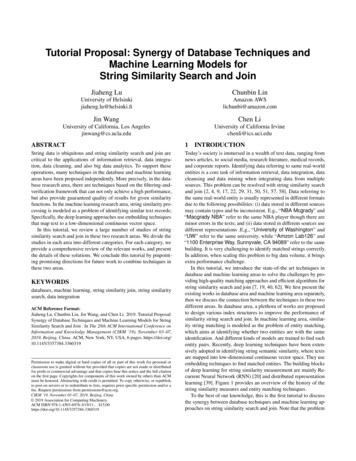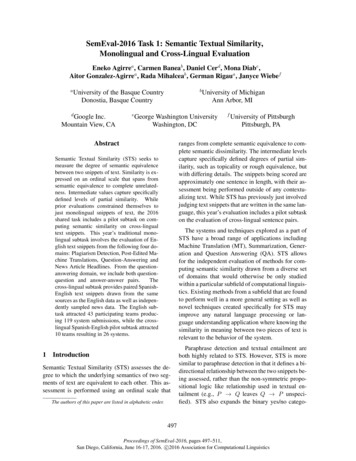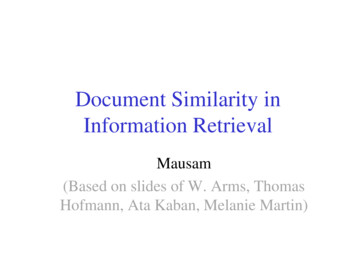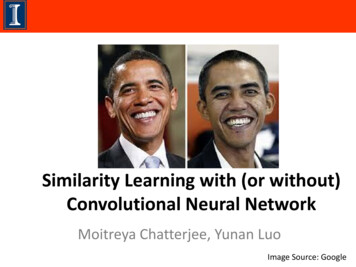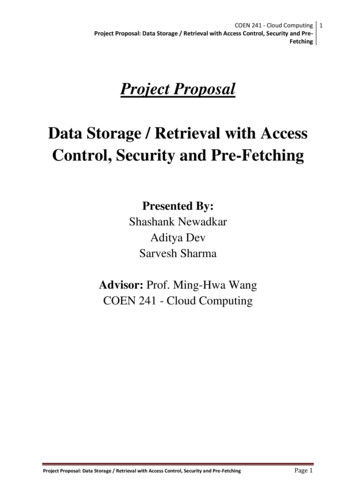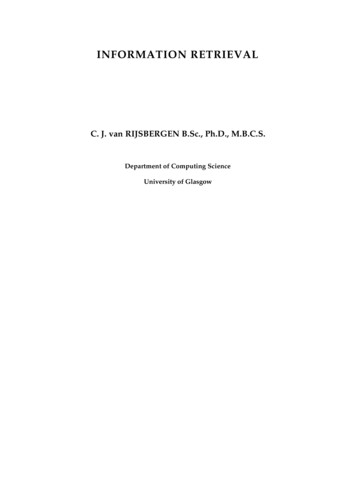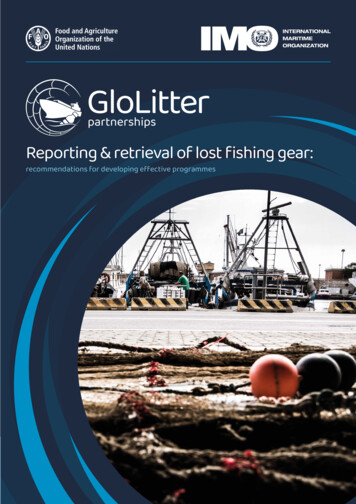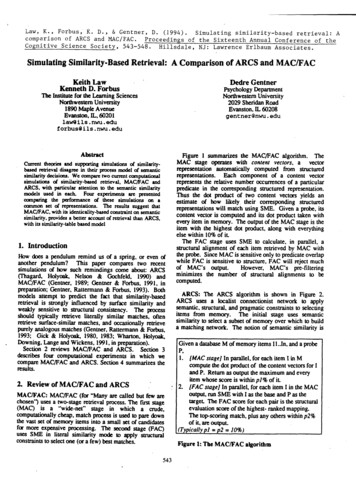
Transcription
Law, K . , Forbus, K. D., 6 Gentner, D. ( 1 9 9 4 ) . Simulating similarity-based retrieval: Acomparison of ARCS and MACIFAC. Proceedings of the Sixteenth Annual Conference of theCognitive Science Society, 5 4 3 - 5 4 8 . Hillsdale, NJ: Lawrence Erlbaum Associates.Simulating Similarity-Based Retrieval: A Comparison of ARCS and MAC/FACDedre GentnerKeith LawKenneth D. ForbusPsychology DepartmentNorthwestern University2029 Sheridan RoadEvanston, IL 60208gentner4nwu.eduThe Institute f a t the Leaming SciencesNorthwestern University1890 Maple AvenueEvanston, IL. tlilcorh and supporting simulations of similaritybased retrieval disagree in their pDcess model of m a n t i csimilarity decisions. We compare two current cornputatidsimulations d similarity-ked retrieval, h4AC/FAC andARCS, with particular attention to the semantic similaritymodcls used in each. Fwr experiments are presentedcunpciring the pcrfmmance d these simulations on acarunon set of representations. The results suggest thatMAC/FAC, with its identicality-basedconstraint on semanticsimilarity. provides a better account of retrieval than ARCS,with its similarity-table based model1. Introduction.How does a pendulum remind us of a spring, or even danother pendulum? This paper compares two recentsimulations of how such remindings come about: ARCS(Thagard, Holyoak, Nelson & Gochfeld, 1990) andMACFAC (Gentner. 1989; Gentner & Forbus, 1991, inpreparation; Gentner, Rattermann & Forbus, 1993). Bothmodels attempt to predict the fact that similarity-basedretrieval is strongly influenced by surface similarity andweakly sensitive to structural consistency. The processshould typically retrieve literally similar matches, oftenretrieve surface-similar matches, and occasionally retrievepurely analogous matches (Gentner, Rattermann & Forbus,1993; Gick & Holyoalr, 1980, 1983; Wharton,Holyoak,Downing, Lange and Wickens, 1991, in preparation).Section 2 reviews MACFAC and ARCS. Section 3describes four computational experiments in which wecompare MACFAC and ARCS. Section 4 summarizes theRSUlts.2. Review of MACIF’AC and ARCSMAC/FAC: MACFAC (for “Many are called but few arcchosen’? uses a two-stage retrieval process. The f d stage(MAC) is a “wide-net” stage in which a crude,computationally cheap, match pmcess is used to pare downthe vast set of memory items into a small set of candidatesfor more expensive processing. The second stage P A C )uses S M E in literal similarity mode to apply structuralconstraints to select one (ora few) best matches.543Figure 1 summarizes the MACFAC algorithm. TheMAC stage operates with content vectors, a vectorrepresentation automatically computed from structuredreprescntations. Each component of a content vectorrepresents the relative number Occurrences of a particularpredicate in the corresponding structured representation.Thus the dot product of two content v w t m yields anestimate of how likely their corresponding structuredrepresentations will match using SME. Given a probe, itscontent vector is computed and its dot product taken withevery item in memory. The output of the MAC stage is theitem with the highest dot product, along with everythingelse within 10% of i tThe FAC stage uses S M E to calculate, in parallel, astructural alignment of each item retrieved by MAC withthe probe. Since MAC is sensitive only to predicate overlapwhile FAC is sensitive to structure, FAC will reject muchof MAC’S output.However, MAC’S pre-filteringminimizes the number of structural alignments to becomputed.ARCS The ARCS algorithm is shown in Figure 2.ARCS uses a localist connectionist network to applysemantic, structural, and pragmatic constraints to selectingitems from memory. The initial stage uses semanticsimilarity to select a subset of memory over which to builda matching network. The notion of semantic similarity is Given a database M of memory items I l .In, and a probeP,1. [MAC stage] In parallel, for each item I in Mcompute the dot product of the content vectors for Iand P. Return as output the maximum and everyitem whose score is within p l 8 of it.2. [FAC stuge] In parallel, for each item I in the MACoutput, SMEwithIasthebaseandPasthetarget The FAC score for each pair is the structuralevaluation score of the highest- mked mapping.The topscoring match, plus any others within p 2 8of it, are output.(Typically p l p 2 1096)Kgun 1: The MAC/FAC algorithm
We prefer an identicality-based axount usinginexpensive inference techniques to suggest ways to rerepresent non-identical relations into a canonidrepresentation language. Such canonicaIization has manyadvantages for compkx, rich knowledge systems, wheremeaning arises fnwn the axioms that predicates participatein. When mismatches occur in a context where it isdesirable to make the match, we assume that people makeuse.of techniques d re-teptesentation. An example of aninexpensive inference technique to suggest rerepresentation is Fakenhainer's (1987, 1990) minimalascension method, which looks far common superordinates(e.g., 'IRANSFER) when context suggested that twopredicates should match (e . BESTOW and DONATE).Semantic similarity can thus be captured as partial identity.We believe thaf WordNet could be used similarly, since ithas superordinate infmation.Holyoak & Thagard have argued that broader (i.e.,weaker) rotions of semantic similarity are crucial inretrieval, for otherwise we would suffer from too manymissed retrievals. Although this at fvst sounds reasonable,there is a counter-argument based on memory size. Humanmemories w far larger than any cognitive simulation yetconstructed. In such a case, the problem of false positives(Le., too many irrelevant retrievals) becomes critical. Falsenegatives are of cwse a problem, but they can be overcometo m e extent by refomulating and re-representing theprobe, treating memory access as an iterative p.ocessinterleaved with other forms of reasoning (as in Wharton,Holyoak, Downing, Lange & Wickens's (1991, in press)RE?vlIND model). Thus we argue that strong semanticsimilarity constraints, wmbined with rewepresentation, arecrucial in retrieval as well as in mapping.How do these different accounts of semantic similarityfare in predicting patterns of retrieval? In the rest of thepaper we compare the performance of MACFAC andARCS on a variety of examples.Given a pool of memory items 11.h and a probe P:1. For each item Li, include it in a matching network ifthere are any predicates in Ii that are stmanticallysimilar to a predicate in P. The matchingnetworkimplements semantic and structurai consmints.2. Create inhibitory links betwear units representingannpeting Fttrievalhypotheses, to ensureampetitive retrieval.3. Install pragmatic constaints by creating excitatorylinks between a special pragmatic node and everypredicate marked by the user as important.4. Run the network until it settles.F m 2: The ARCS &orithrnbased on WordNet (Miller, Fellbaum, Kegl, & Miller,1988). a psycholinguistic databâse of words and lexicalconcepts. Since Thagard et al. draw the majority of theirpredicate vocabulary from WordNeef the existence of lexicalrelationships between words is used to suggest that theircorresponding predicates are semantically similar.Most of the woz1: in ARCS is canied out by theconstraint satisfaction network, which provides an elegantmechanism for integrating the disparate constraints thatThagard et al. postulate as important to retrieval. The useof competition in retrieval is designed to reduce the numberof candidates retrieved. Using pragmatic informationprovides a means far the system's goals to affect therenieval process.After the network settles, an ordering can be placed onnodes representing retrieval hypotheses based on theiractivation. Unfomnately, we have not been able to identifya formal criterion by which a subset of these retrievalhypotheses are considered to be what is retrieved by ARCS.In the experiments below we mainly focus on the subset dretrieval nodes mentioned by Thagard et al. in their paper.2.1 Semantic SimilarityA key issue in analogical processing is what criterionshould be used to decide if two elements can be placed intocorrespondence. In ARCS, an augmented subset dWordNet was used to make semantic similarity decisions.Two predicates in ARCS are considered semanticallysimilar if their c o m p d i n g lexical concepts in WordNetare connected via links that denote particular relationships.The use of WordNet as a database far simple lexicalinferences is an appealing idea. The lexical connectionsfound in this way should have well-founded motivations.Nevertheless, it important to remember that W W e t wasintended as a lexicon, not a language of thought. Using thelexical concepts of Word.Net as a predicate vocabularyrequires assuming that there exist conceptualrepresentations that correspond to these lexical concepts.That does not Seem an implausible assumption. However.assuming that relationships between words, such assynonym or untonym are used in the cognitive processing dinternal representations Seems implausible,3. Computational ExperimentsEach experiment below has a similar structure. First eachsimulation is given a memory, consisting of one or moredatabases drawn from the ARCS representations.' Thenretrieval is tested with probes drawn drom a smallpredefined set of stories. The memory a simulationopexatesoveroonsistsofonewmoredatabases. Insanecases the memory is augmented by a particulat s c y :e.g.,when probing with variant Hawk stories, the Thagard et al.encoding of the "Karla the Hawk" story is added tomemory. (This is done to see if the retrieval system is ableto f i the base story amidst the distractors, givenvariations on the story as probes.)For brevity we specify the probe set and memorycontents symbolically, using ''r to distinguish pmbe setfrom memory and *' " to indicate set union. Thus1To date we have been unsuccessful in geaing ARCS to run mthe representationswe used in (ForbusBi Gcntner, 1991). AR-'network Q t s not settle after evar 1.OOO iterations, and run timesof up (O nine hours have been required.544
HAWK/(PLAYS Karla Base) indicates an experimentwhere the database d plays was probed with the Hawkstorits. A description ofthe datasets used and a summaryof conventions a given in Figure 3.Both M A W A C and ARCS take propositionalrepresentations as inputs, but their representationconventions are quite different The most crucial differenceis that structure-mapping beats attributes, relations, andfunctions differently, whereas ARCS does not distinguishthem. We used thc following d e s in translation: (1) Onephce predicates w e n classified as attributes, (2) multiargument predicates were ciassifiecd as relations, and (3)since the arguments to CAUSE could be either events ormodal propositions, we treated predicates used asarguments to a CAUSE statement either as modal relations(e.g., BECOMING-TRUE)OT functions (e.g., MARRIED,RobeSour Grapes,appearanceSour Grapes,Sour Grapes,120Sour Grapes (0.21)81Sour Grapes (0.25)123utcralsimilprityProbeResultssecSour C r a wF A C Sour Grapes (053)MAC: Sour Grapes (056)F A C S a u Grapes (2.03)MAC:Sour Grapes (0.62)FAC: Sour Grapes (2.03)M A C Sour Grapes (0.62)0.3appearanceSour Grapes,analogSour Grapes,literal similarityReplication of computational expediments is stillsomething of a novelty, and standards far ensuring thatreported simulation results are repeatable have not yet beenestablished in cognitive science. Nevertheless, we havetaken many precautions to ensure that we have run ARCSoorrectly. Where numerical information was reported, forinsrance, we matched results to several decimal places.One concern was what should count as a retrieval in ARCS.Neither the original ARCS paper mr the cock defines aDatabases:FABLES 100 encodings of Aesop’s fables, encoded byF w r e 3: Databases and experimental stories used intbe experimentssecSour Grapes (0.28)analog-1.Thagard et al.PLAYS 25 encodings of Shakespeare’s plays, encodedby Thagard et al.sets u s e w b e s and memow itemsHAWK Thagard et d.’s encoding of the “Karla theHawk story set, Le., original story, analog, appearancematch, false analogy, and literal similarity versions.Databases using these probes have the original storyadded to memory, except when the Original story itself isusedasaprobe.SG Ifhagard et al.%encoding of the Sour Grapes fableplus variations, i.e., original story, analog, appearance,and literal similarity versions. Databases using theseprobes have the original story added to memory. exceptwhen the original stmy itself is used as a probe.H&WSS Thagard et d.’s encoding of Hamlet and WesiSide Story. When Hamlet is used as aprobe it isremoved from memory. West Side Story is neva placedin memory.Convention; For convenience, we pder to anexperimental setup by the probe stories followed by thedatabase used,e.g., SG/(FABL S PLAYS) means thatthe Sour Grapes fables were used as probes with amemory consisting of both plays and fables. When astory is used as a probe, it is removed from memory fmt.Results0.20.23.1 Experiment 1: Sour Grapes ComparisonIn the fmt study the memory set consists of the fables,including the Sour Grapes fable, and the probes arevariants of Sour Grapes. Table 1 shows the results. Theresults far ARCS match those reported far the simulationby Thagard et al. The MACFAC results are quite similar.Thus both systems successfully retrieve Sour Grapes from adatabase of fables when given variations of it. However,MACRAC is substantially faster. The runtime difference isfairly typical; MAC/FAC tends to be two orders ofmagnitude faster than ARCS when tested with identicaldata on the same computer.3.2 Experiment 2: Effets of additional memoryitems on retrieval (Sour Grapes)To check the stability of results under changes in memorycontents, we reran Experiment 1, adding the database of 25Shakespeare plays encoded by Thagard et al. to the fablesdatabase. We then tested the simulations to see if theywould retrieve Sour Grapes from the database of 125 fables, and plays when p r o b e d with variations of Sour Grapes. Theresults are show in Table 2. MACFAC’s results remainunchanged, except for a small increase in processing time.ARCS, on the other hand, is distracted by the plays in oneof the probe conditions. Increasing the memory by 25%has led to different results with ARCS. The results alsohint at a possible size bias in ARCS: it appears to preferlarger descriptions in retrieval, at the cost of c o m tmatches.545
Probeswr GrapesResultssour Grapes (0.28)srcThe Tuning of the Shrew251specific: to retrieve Romeo & Juliet the analogous play.Table 3 shows the results for plays only in memory,andTable 4 shows the results with both plays and Eables inmemory. The good news f a ARCS is that the fables haveonly minimally intrudedm the activation fa the topranked retrieved plays. A Midsummer Night’s dream isARCS’ topranked retrieval for West Si& Story, but it didalso, as stated by IIhagard et al., retrieve Romeo Bi Juliet.MAC/FAC, on the other hand, only retrieves Romeo &Juliet with eitha probe. For West Side Story this is indeedthe expected result (and we believe more intuitive thatARCS’ result), but what is happening with Hamlet?Examining the structural evaluation scores (e.&, the FACscores) reveals that FAC considers the match between West327appearanctSour G r a m(0.22).urploeSour crape&Mary Wives (0.18).(1 1 stories].Sour Oram (-0.19)Sour Grapes (0.25)373LttcrdrlmiMtyRobcSour GrapesappearanceSour Grapesan iog:Sour Grapes,literal similarityResultsFAC Sap Grapui (053)MAC: Swr Grapes (056)FAC Sau Grapes (2.03)MAC Sour Grapes (0.62)FAC Sour Grapes (2.03)M A C Sour Grapes (0.62)sec0.4Side Story and Romeo & Juliet to be excellent (16.51).which makes sense because the modings of West SideStory and Romeo Bi Juliet have almost isomorphicstructure. When Hamlet is the probe, FAC is relativelyindifferent: the FAC scores were as follows: Romeo &Juliet (6.79). Julius Caesar (5.49). Macbeth (3.72). Othello(2.67). The dropoff from Romeo & Juliet is 202, which isbelow than MACFAC’s default cutoff of 10%.0.30.3Table 2: Results of SG probes, database Fables mys3.3 Experiment 3: Larger Probe sizesWhile the results for MACFAC in Experiment 2 aresatisfactory, ARCS’ seemingly poor performance requiresfurther investigation. Does the relative size of the probematter in the memory swamping effect? To find this outwe again ran both simulations, fvst with the plays dabbaseas memory, then with the 25 plays and 100 fables asmemory, this time using as probes the Hamlet and WestSide Story encodings as p b e s , as represented by Thagardet al. Given Hamlet as a probe, the question is whether thesystems can retrieve a tragedy, or at least another play.Given West Side Story as a probe, the challenge is moreARCS results. Numbers in parentheses represent levelsof activation for that item.3.4 Experiment 4: Hawk storiesThe goal in the Hawk studies was to replicate the results of(Gentner, Rattermann, & Forbus, 1993). Subjects were,given a set of stories to read, and later attempted to retrievethese stories given variations as probes. The observedretrieval ordering was literal similarity, appearance,analogy, fmt-order overlap. Thagard et al. simulated thisexperiment for one story set. Using the dative activationlevels of the stones computed by ARCS as relative retrievalprobabilities for human subjects, ARCS’ order of retrievalwas: literal similarity, fus-order overlap, appearance,analogy. This is not a close match. (Our own simulation ofthese results with MACFAC matched the human ordinalresults.)ARCS Results.ResultsRobeHamletOthe110 (0.46), Cymbeline (0.42).I ResultsI Romeo & Juliet (0531).lSeCI4112King Lear (0.528). Othello (0.45),Cymbcline (0.41). Macbeth (0.40).Romeo & Juliet (0.57)RobeHamktResultsFAC: Romeo & Julia (6.791MAC: Othello (0.86). Mack& (OS),Romeo & Juliet (0.83).I Julius Caesar (0.81)West Side I FAC Romeo & Juliet (1651)StoryMAC: Romeo & Julict‘(O.88)IsecMAC/FAC ResultsRobeIResultsI*22HamletI26I FAC Romeo & Juliet (6.79)MAC:Othello (0.86). Macbeth (0.85).Romeo & Juliet (0.83). Caesar (0.81),1I13ITable 3: Results for Hamlet, West Side Story asTable 4: Results for Hamlet, West Side Story asprobes, Plays Fables database.probe& Rags database.546,
However, w purpose here is to pursue two specifu:questions. Using Thagard et a.’s encodings, we ask (1) Qthe systems mom appropriately: and (2) do the twosystems continue to perfonn appropriately when distractorsare added to memmy? Both simulations were run with theHawk Storiesas pmbes, and with either the hbles (plus theKarla story) as memory or with both fables and plays (plusthe Karla story) as memory. ?he results are shown inTable 5 and Table 6 mpectively.No matter which database is used, MAC/FAC alwaysretrieves the Karla story, irrespective of which variant stayis usedas a probe. The MAC scores explain why: In eachcase the Karla story isat the topofthe ranking, indicatingthat the predicate overlap is greater for Karla and variantthan for any other story. The fact that the Karla base stayis mrieved for the literal similarity and appearancevariants is expected. Its retrieval when the analogy is usedas a probe is also reasonable (although if ARCS alwaysretrieved analogs successfully it would be an implausiblemodel). Retrieving the base story when the f d a r d e roverlap story is used as a p b e is not so reasonable. Webelieve this occurs because the Thagard et al.representations are rather sparse, with almost no surfaceinformation,and thus are less natural than might be desiredmbcKarla,literal der overlapMAC/FAC ResultsRobeKarla,literal similarityKarla,appcoranceResults“Karla” base (0.67)Fable55 (0.4). (7 fables],“Karla” base (-0.17)Fable23 (0.33). [7 fables],“Karla” base (-0.27)Fable23 (0.0907).Fable55 (0.0903). [ 13 fables].“Karla” base (4.1 1)scc315176(cl. the specifcity conjecture of Forbus & Gentner, 1989).As WBS suggested by experiments 1 and 2, the ARCSmuits vary considerably with different distractor sets. Thismeans that the use of relative activations to estimaterelative frequencies is not a stable measure. Specifically,the relative ordering of firstoverlap and analogyreverses when the database of bbles is augmented with theplays. The position of the Karla story in the activationrankings is also alarming. The appearance stoiy, whichRobeK 4Uternl similarityhlea al uKarla,llrstorderoverlapFAC: “Karla” (5.33).Karla,firs!.ordcr overlap FableS (5.33)MAC.“Karla” (0.73).Fable7l(0.7 1). Fabld2(0.7 1).FablcS(0.71). FabldS(0.69).Fablc59(0.68).Fable27(0.68)Tabk 5: Resutts for HAWK probes, database Fables “Kario” base storyFable55 (0.40),[16 stories].I“Karla” base (-6.018)I Pericks (0.60). (17 rtaics].”Karla” base (-0.32)Pericles (058). 122 stories],”Karla” base (-0.38)MAC/FAC Result12717ResultsFAC: ‘Karla” (1 6.07)MAC “Karla” (0.81).Fable71 (0.74)IFAC: “Karla” (7.92)17MAC: “KarlaW’(0.7i),Fable52 (0.71). Fablc71(0.66),Fable27(0.65). FableS(0.64)FAC: “Karla” (8.571I 14MAC: ”Karla”(O.81).Fable52 (0.77). Fable5 (0.77).Fable71(0.76). FabM5(0.75).Results“Karla” base (0.67)ResultsFAC: “Karla”( 16.07)MAC. “Karla”(0.8 1),Fable71 (0.74)FAC: “Karla” (7.92).MAC “Karla” (0.71).Fable52(0.7 1),Julius Caesar (0.69).Othello (0.68).Macbeth (0.67).Fable71(0.66). Two Gentlemenof Verona (0.65).Fable27(0.65), Hamlet (0.65).FableS(0.64)FAC: ‘Xarle”(8.57)MAC “Karla’;(0.81).Julius Caesar (0.78). TwoGentlemen of Verona (0.78).Fable52 (0.77). Fabld(0.77).Macbeth (0.76).As You Like It(0.76).Fable71(0.76). Fable45(0.75).Fable59(0.75), Fable27(0.75),Othello(0.75)FAC: “Karla”(5.33).FablcS(5.33).As You Like It (4.96)MAC ”Karla”(O.73).Julius C.esar(0.72). TwoGentlemen of Verona (0.72).Fable71(0.71), Fable52(0.71).Fable5 (0.71). Macbeth(0.70).As You Like It (0.70).orhello (0.69). Fablo45 bk 6 Results for HAWK probes, with database Fables Plays %ah” base story541
should retrieve the lase h o s t as ofka as the literalsimilarity story, has dropped frwn ninth in the ranking to18th. Depending on the retrieval cutoff, the conclusionmight bt that ARCS fails lo retrieve the Karla story giventbe very cbse s u r f e match.4. conc)usionsIbe results of cognitive simukuion experiments mustdways te intaprtttd with care. in this case, we believeexpaimtnts pmvide evidence that -tun-mapping'sidarticality consbaint beua models retrieval than Thagardet J.'s nolion d semantic similarity. ln retrieval, thespecial demands d large memories argue far simplerJgarithms, simply )rrsurp. the cosl of false positives ismuch higher. If rttrieval w a e a one-shot operation, thecost al false negatives would be higher. But in normalsituations, ntrieval is iterative, interleaved with thec nsouctionof the rcprcsentations being used. Thus thecost of false negatives is reduced by the chanoc thatreformulalion of the probe. due to re-repsentation andinference, will subsequently calch a rclevant memory thatslipped by owe.Finally, we note that while ARCS' use of a bcalistconnectionist network to implement constraint satisfactionis in many ways intuitively appealing, it is by no meansclear that such implementatjons lu c oturally plausible.Overall, we believe the evidence suggests that MACFACcaptures similarity-based retrieval phenomena betla thanolprARCS does.5. AcknowledgmentsWe thank Paul Thagard and Keith Holyoak for providingACME, ARCS, and advice on operating them. Thisresearch was funded by the Cognitive Science Division dthe Cffce of Naval Research.6. BibliographyFalkenhainer, B. (1987).An examination of the third stagein the anaiogy process: Verification-based analogicallearning. In Proceedings of NCAI-87. Lm Altos:Morgan Kaufmann.Falkenhainer, B. (1990).A unified approach to explanationand theory formation. In Shrager, J. & Langley, P,@dis.), Compuiaiional Models of Scientific Discoveryand Theory Formaiion. Morgan Kaufmann.Falkenhainer, B. Forbus, K., Bi Gentner, D. (1989).TheStructure-Mapping Engine: Algorithm and Examples.Ariificial lnielligence, 41, 143.Forbus, K. & Gentmr, D.(1989). Srmctrrral evaiuation ofanalogies: What counts?In Proceedings of ihe EleventhAnnual Conference of the Cognitive Science Society.Hillsdale, NI:Lawrence Erlbaum Associates.Forbus, K. & Gentner. D. (submitled). MAC/FAC: Amcture-mapping model of similarity-based retrieval.548Gcntner. D. (1989). Ihe mechanisms of analogicalkaming. In S. Vosliadw & A Onony (eds.) SimilarityMd AMlOgiCd Reasoning @p. 199-241). k w Y&Cambridge University Res.Gentncr, D. & Forbus, K. (1991). M A W A C A modcl drimilarity-based retrieval. in Proceedings of theThirieenth Annual cfonference of rhe Cognitive ScienceSociety. Hillsdale, NJ:Lawrence Mbaum AssociateS.Gentnu, D. Rautrmann, M. Bt Farbus, K. (1993). Themks of similarity in hansfex Separating rtbievabilityfnwn inferential soundness. Cogniiivr Psychology, 25,524-515.Gick, M., Bt Hdyœk, K. (1980). Analogical @lemrolving. Cognitive Psychology, 12.306-355.Gick, M,& Hdyaal, K. (1983). Schema induction andanalogical transfer. Cognirive Psychology. 15, 1-38.Holyoak, K. & 'hagard, P. (1989)Analogical mapping byconseaint satisfaction. Cogniiive Science, 13(3), 295355.Miller, G., Fcllbaum, C., Kcgl, J. & Miller, K. (1988).WordNet: An electronic lexical seference system basedon theories of kxical memory, Revw QucbccoiseLinguisiiquc, 16,181-213.Thagard, P. Hdyoak K. Nelson, G., & Gochfield. D.(1990). Analogical retrieval by constraint satisfaction.Ariificial Intelligence, 46(3), 259-310.Wharton, C. Holyoak, K., Downing, P., Lange, T. &Wickens, T. (1991). Retrieval competition in memory foranalogs. In Proceedings of the Thirteenth AnnualConference of the Cognitive Science Society @p. 528533). Hillsdale, NJ:Lawrence Erlbaum Associates.Wharton, C., Holyoak, K., Downing, P., Lange, T.,Wickens, T., & Melz, E. (in press). Below the -e:Analogical Similarity and retrieval competition inreminding. Cognitive Psychology.
added to memory, except when the Original story itself is usedasaprobe. SG Ifhagard et al.% encoding of the Sour Grapes fable plus variations, i.e., original story, analog, appearance, and literal similarity versions. Databases using these probes have the original story added to memory. except when the original stmy itself is used as a probe.
